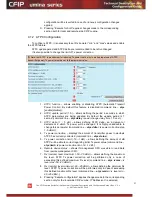
The CFIP Lumina Series Full Outdoor Unit Technical Description and Configuration Guide
•
Rev. 1.3
•
© SAF Tehnika JSC 2010
26
After accepting and pressing „Next step >>‟ button, you will be redirected to the second
configuration wizard screen, where you will be asked to define the network IP settings by
entering IP address, IP mask, default gateway and remote link side IP address.
Figure 2.14.
STEP 2. Defining IP address, mask, default gateway and remote IP address
The third screen of the wizard is devoted to the modem and radio configuration and
requires specifying utilized bandwidth (20, 28, 30, 40, 50 or 56 MHz), modulation type (QPSK,
16APSK, 32APSK, 64QAM, 128QAM or 256QAM), Tx power (range depends on modulation
chosen) and Tx frequency (range depends on bandwidth chosen); besides, the modem and
radio data status is being shown.
These configuration parameters will determine overall link capacity.
Figure 2.15.
STEP 3. Defining modem bandwidth, modulation, Tx power and frequency
For CFIP Lumina 24GHz Tx power should not trespass equivalent isotropically radiated
power (EIRP) limitation of 20 dBm.
The final screen allows checking the selected settings and applying them. The optional
settings are as follows:
–
Clear cfg file before the new settings will take place
– resetting or keeping all the
other parameters, not mentioned here, after configuration execution
–
Set local machine time
– uses the time of your laptop
–
Write this configuration into cfg file
– configuration is automatically written in
configuration file
(!)
In the table below please see interdependence between antenna used and allowed
CFIP Lumina 24
GHz Tx output power range (EIRP ≤ 20 dBm).
Antenna size/gain
30cm / 35.0dBi
60cm / 40.3dBi
Tx power
-20
…-15 dBm
-20 dBm






























